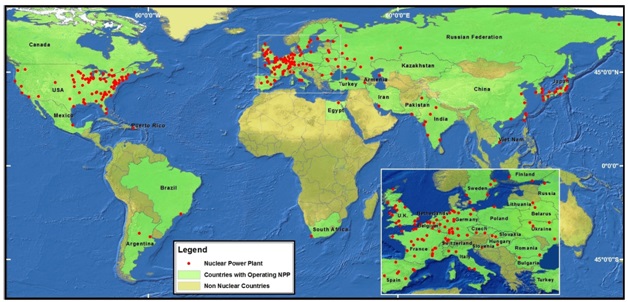Part One of Two Parts
Promoters of nuclear power claim that it is one of the most inexpensive, safe and efficient form of electrical energy generation. Critics dispute all of these claims and point out other serious problems with nuclear power. Following the nuclear disaster at Fukushima in March of 2011, many national nuclear programs around the world were suspended to study the causes of the disaster. Japan temporarily shut down all nuclear power, some countries scaled back plans for nuclear expansion and others decided to shut down all their reactors permanently. While the construction of nuclear power reactors in most advanced nations is now rare, a few nuclear nations such as Russia and China are moving forward aggressively to construct many new power reactors. There is also a big push among nations which have advanced nuclear technology to export that technology and construct nuclear power plants in developing nations to aid their economic development.
Recently the United Nations International Atomic Energy Agency published a list of the nations which obtain a significant amount of their electricity from nuclear power.
Prior to the Fukushima accident when Japan temporarily shut down all of its reactors, Japan got about thirty percent of its electricity or seventeen gigawatt-hours from its fifty nuclear power reactors and had plans for expansion. Now they are committed to restarting about two thirds of their reactors.
Finland gets twenty two gigawatt-hours or about thirty two and one half percent of its power from four operating nuclear reactors. A fifth power reactor under construction is behind schedule and over budget.
Switzerland has five reactors that provide about thirty six percent of its electricity or about twenty four and a half gigawatt-hours. They plan to close all their reactors by 2035.
The Czech Republic has six reactors that provide about thirty five percent of its electricity or twenty eight and a half gigawatt-hours. While nuclear power is popular in the CR, arguments over the government's future energy plans have stalled plans for four new reactors.
India's twenty reactors produce almost thirty gigawatt-hours but that represents less than four percent of its electricity. There are ambitious plans for expanding the share of nuclear power. India wants to get twenty five percent of its power from nuclear by 2050.
Belgium has seven reactors that produce about thirty eight and a half gigawatt-hours for fifty one percent of their electricity. Belgium is committed to phasing out all nuclear power generation by 2025.
Spain generates almost fifty nine gigawatt-hours from eight nuclear reactors. This supplies about twenty percent of their electricity. No new reactors have been built there for twenty years and Spain has announced that it will phase out all nuclear power and replace it with wind and solar as soon as it is practical.
Sweden's ten reactors produce sixty one and a half gigawatt-hours or thirty eight percent of its electricity. Sweden has been phasing out nuclear power generation since 1980. Recently, the government of Sweden reversed the phase-out policy, started modernizing existing reactors and is considering new builds.
The United Kingdom has eighteen reactors producing sixty four gigawatt-hours or eighteen percent of its electricity. After reaching a peak production of twenty five percent fifteen years ago, the closure of old plants has brought the percent of nuclear down to its current level. The government has been promoting nuclear power lately and has plans for eleven new reactors to produce sixteen gigawatt-hours by 2025.
Ukraine's fifteen reactors produce about eighty five gigawatt-hours of electricity for forty six percent of Ukraine's electricity. Although Ukraine is still coping with the aftermath of the 1986 Chernobyl nuclear disaster, it is still bullish on nuclear power with plans for eleven new reactors by 2030.
(See Part Two)
Global Nuclear Power Plants:
